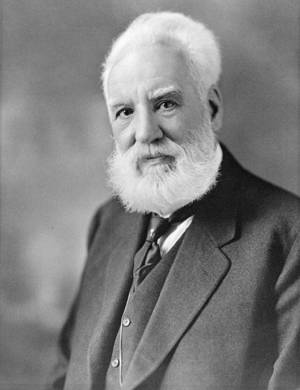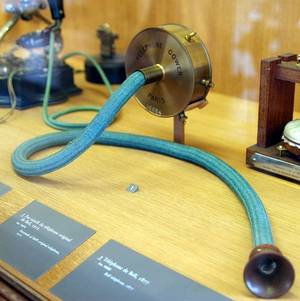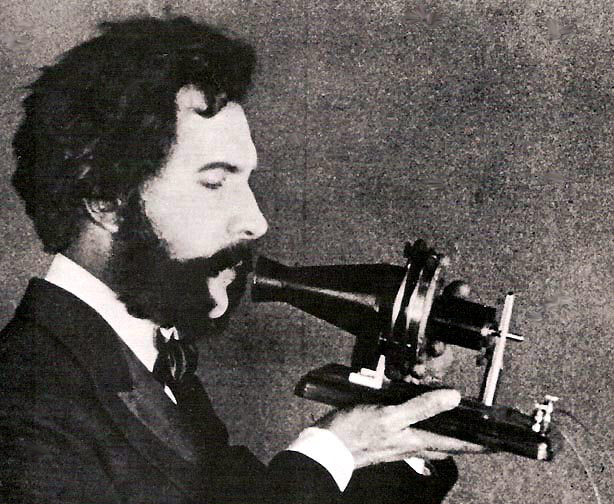This Week in Science History - The First Phone Call
Interview with
This week in science history, on 10th March 1876, there was the first documented 2-way transmission of clear human speech between Alexander Graham Bell and his assistant Mr Watson, with the famous phrase "Mr Watson, come here...I want to see you". This first two way conversation marked the beginning of something that is now an overlooked part of everyday life, and although this was one of the most famous occasions in the story of the invention of the telephone, there were many other players involved, not just Bell.
 Bell was born and educated in Scotland, and even as a child had been fascinated by the production of sound and language and how it could be reproduced mechanically. This early interest may have been sparked by the fact that his mother was deaf, and his father worked as a speech therapist.
Bell was born and educated in Scotland, and even as a child had been fascinated by the production of sound and language and how it could be reproduced mechanically. This early interest may have been sparked by the fact that his mother was deaf, and his father worked as a speech therapist.
As an adult, his first real experiments that led him into his work on the telephone focused on the artificial production of speech - using a set of differently tuned reeds, a bit like the strings of a harp, to produce different tones according to an alternating current that passed through them. This moved on to producing vowel sounds, which was something other scientists at the time had also achieved, much to Bell's disappointment. But he thought, well if we can make vowel sounds, then why shouldn't consonants and articulate speech be made too?
It was in the early 1870s that the idea of capturing a real voice and using that to generate the current that drove the artificial speech production at the other end really leapt forward. Several scientists, across Europe and in Canada and America, where Bell was living and working, came up with solutions to the problem of how to convert human speech into electrical current, and how to convert that back into speech again.
Two of these solutions - the liquid microphone, an idea that Bell may or may not have pinched from the American Elias Grey, and the electromagnetic microphone, developed both by Bell and by the Italian Antonio Meucci, another contender to the title of the inventor of the telephone.
 The water microphone, that Bell used in this famous demonstration on the 10th of March, works as follows - the transmitting subject spoke into one end of a tube, and the opposite end was covered in a thin diaphragm of paper or animal skin with a small needle attached to it. When the speech vibrated the diaphragm, the point of the needle would become more or less immersed in a liquid. Another wire measured the change in conductivity in the liquid as the metal needle became more or less submerged. This changed the current in the wire, which cause a rudimentary 'earpiece' to vibrate and produce a copy of the original speech. What's quite controversial is that this apparatus is quite different from that of Bell's previous experiments and was quickly abandoned by him, in favour of the more efficient electromagnet microphone.
The water microphone, that Bell used in this famous demonstration on the 10th of March, works as follows - the transmitting subject spoke into one end of a tube, and the opposite end was covered in a thin diaphragm of paper or animal skin with a small needle attached to it. When the speech vibrated the diaphragm, the point of the needle would become more or less immersed in a liquid. Another wire measured the change in conductivity in the liquid as the metal needle became more or less submerged. This changed the current in the wire, which cause a rudimentary 'earpiece' to vibrate and produce a copy of the original speech. What's quite controversial is that this apparatus is quite different from that of Bell's previous experiments and was quickly abandoned by him, in favour of the more efficient electromagnet microphone.
This works by the principle that moving a piece of soft iron in and out of a coil of wire that is held in a magnetic field will induce a voltage in the coil. The resulting change in current flow causes the exact opposite to happen at the earpiece - the voltage change in a coil at that end causes a flat disc-like piece of soft iron to vibrate in and out of the end of the coil according to the frequency of the sound that went in at the other end. This vibration reproduces the speech. It is by this principle that most high quality microphones , like the one I'm using right now, still work today, although those in telephones use a different sort - the carbon granule microphone invented by Edison.
 The events of the 10th of March were soon followed by Bell and Watson in August of the same year with the first long distance transmission - over 5 miles. From here, everything about the telephone has been under constant improvement - the distance, the sound quality, the volume, and more recently, the wireless then the mobile phone.
The events of the 10th of March were soon followed by Bell and Watson in August of the same year with the first long distance transmission - over 5 miles. From here, everything about the telephone has been under constant improvement - the distance, the sound quality, the volume, and more recently, the wireless then the mobile phone.
The telephone has revolutionised our world - we can speak to loved ones, friends or business partners thousands of miles away, or get help in an emergency. Bell's work was extremely important in realising the potential of the telephone, but we mustn't forget the other scientists who worked so hard and were just pipped to the patent post by a very talented, or just very lucky man.
- Previous How a Mobile Phone Works
- Next The Science of Sword Swallowing










Comments
Add a comment